The health benefits of cayenne pepper and how to grow it correctly
Cayenne pepper makes the taste of many dishes brighter and richer. In addition, this burning member of the nightshade family has pronounced healing properties.
Why is cayenne pepper called that? The vegetable owes its name to the Iranian city of Cayenne. It was to the Cayenne port that merchants first began to bring the burning fruit from India, which quickly became popular. Today we will tell you what cayenne pepper is and how to eat the fruit correctly so as not to harm the body.
Description of culture
Cayenne pepper is one of the hottest spices in the world. In the wild, the plant is found in tropical climates, where pepper bushes grow up to 1.5 meters in height. The island of Java is considered the birthplace of the culture.
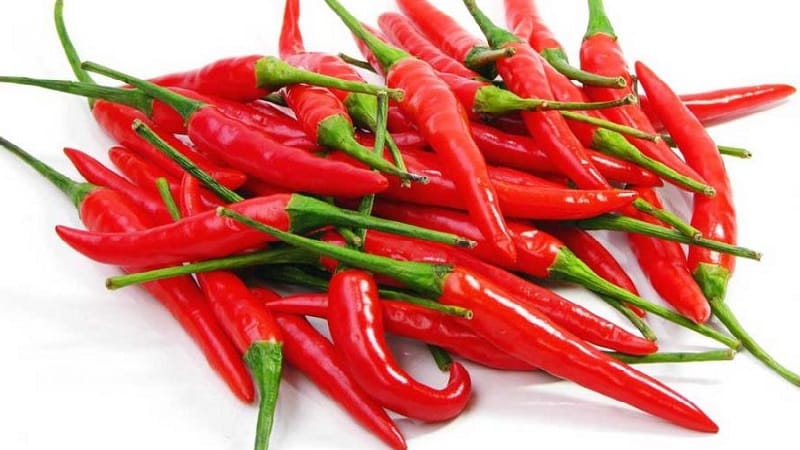
The spicy vegetable has become a very popular seasoning. Now the plant is cultivated all over the world in a variety of climatic zones. In our country, hot fruits are grown mainly in greenhouses. Breeders have developed a large number of varieties of this crop specifically for growing at home.
Small bright red pods give the plant an elegant decorative appearance. The shape of peppers can be very different: spherical, cone-shaped, proboscis-shaped.
The benefits and harms of cayenne pepper
The product has a soft, pleasant aroma and a hot, scalding taste.. Peppers owe their spiciness to a substance called capsaicin, which has many beneficial properties.Capsaicin helps the body resist colds, activates metabolic processes, improves blood circulation and thins the blood, prevents the development of malignant tumors, and protects cells from toxins.
The heat of foods, including peppers, is measured using the Scoville heat scale.. Whether a pepper is hot or not is determined by its capsaicin content. The heat of cayenne pepper ranges from 30,000 to 40,000 units. How many Scovilles does a sweet bell pepper have? Total from 1 to 500, depending on the variety. In addition to capsaicin, cayenne pepper also contains other alkaloids: chavicine and piperidine.
Burning fruits are distinguished by a rich composition of microelements and vitamins. The pods contain fiber, protein, B vitamins (thiamine, pyridoxine, folic acid), as well as C, A, E, K, iron, manganese, potassium.
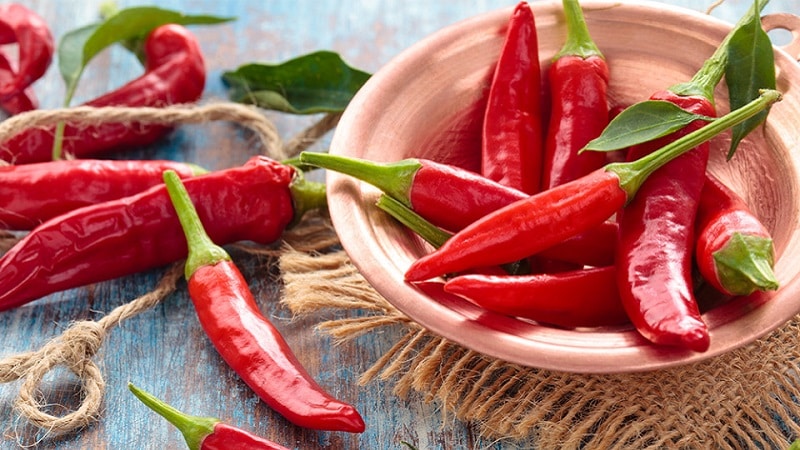
Despite the many useful properties, excessive consumption of a spicy product is dangerous to health, as it causes a burn to the gastric mucosa, gastric upsets and irritates the mucous membranes. Therefore, use hot seasoning in moderation.
Caution must also be observed when preparing dishes with seasoning. You should wear gloves when cutting fresh vegetables.
This is interesting:
What is Dungan pepper and how can it be used?
Fruit characteristics and yield
Cayenne pepper pods are small, 10–20 cm long and up to 2 cm in diameter.. A large number of different varieties of this crop are known. They all differ in the degree of pungency, size, shape and color of the pods. A photo of what cayenne pepper looks like is shown below.
Cayenne pepper is eaten at any stage of maturity.Green peppers have a milder taste; when fully ripe, they are spicy and fiery. Unripe fruits taken from the bush ripen well at home.
Uses of cayenne pepper
Pure cayenne pepper is an expensive and rare spice.. Stores primarily sell spice mixtures called cayenne pepper or chili. The basis of such seasonings is paprika, cumin, oregano, garlic and salt.
Real fresh or dried cayenne pepper is difficult to obtain. You can find the product in specialized spice stores or trusted online stores.
In cooking
The hot seasoning is widely used in the cooking of Asia, Central and South America in raw, dried or ground form. The raw vegetable gives food a piquant taste; it is less pungent than ground.
Spicy pods are consumed as a separate product or in combination with other spices. The seasoning complements fish and meat dishes, hot soups, stews, vegetable salads and even baked goods, desserts, hot chocolate and coffee.
Hot pepper too used as a preservative for food products.
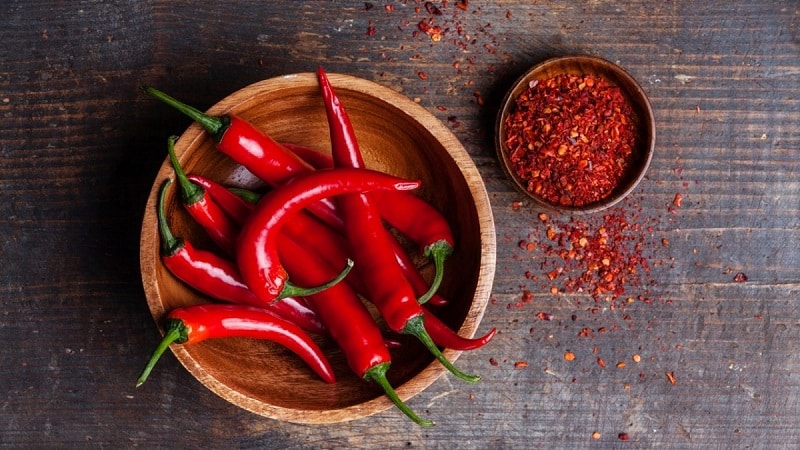
For treatment
Considering that Cayenne pepper has many beneficial qualities and is widely used for medicinal purposes.. Preparations based on this plant are effective in the treatment of diseases of the gastrointestinal tract and hypertension. It is used for pain relief and spasm relief.
There are many recipes for treatment based on burning fruits. Creams and ointments with hot pepper extract relieve pain symptoms and eliminate inflammatory processes in joints and muscles. Special plasters heal wounds and help with toothache. In addition, cayenne pepper has proven effective in treating fungal diseases.
In cosmetology
For cosmetic purposes, spice is added to creams, scrubs, masks., used for anti-cellulite wraps. Such products increase muscle tone, make the skin elastic and toned. To activate blood circulation in the hair follicles, burdock oil is mixed with pepper and applied to the scalp.
Carefully! Cayenne pepper may cause a burn if left on the skin for a long time.
In dietetics
In diets, cayenne pepper is used to speed up metabolic processes in cells. The beneficial properties for weight loss are due to the capsaicin content in the fruit. All food eaten together with seasoning is absorbed faster. At the same time, the body gets rid of toxins and toxic substances.
Important! Treatment with cayenne pepper is prescribed only by a doctor.
It should be understood that the seasoning itself, without exercise and a balanced diet, will not provide significant weight loss.
Contraindications
For some diseases, burning medicine is contraindicated. The walls of the stomach and esophagus are the most sensitive to the product, so the seasoning is used with caution for gastritis, stomach ulcers, and kidney diseases.
Attention! Any use of cayenne pepper is unacceptable in case of individual intolerance or allergic reaction.
Spicy seasoning is not suitable for external use. those who suffer from allergic diseases. Pregnant and nursing mothers should also limit or completely eliminate seasoning from their diet.
Cultivation
Hot capsicum is a close relative of the tomato, and therefore the agricultural technology for growing these crops is similar. If the necessary conditions are met, the bushes grow strong and lush, bloom profusely and bear fruit well.
Seeds can be purchased at the store or taken from pods. Before planting, they are germinated in damp cloth. The sprouts hatch in 2-3 days. Sprouted seeds are planted in seedling containers.
Cayenne pepper is a southern plant, so for normal growth and development he needs a lot of warmth and light. If the leaves turn pale and fall off, it means the peppers are not getting enough sunlight. In this case, additional lamps are installed. After 2-3 pairs of true leaves appear, the plants are transplanted into flower pots (for growing on a windowsill) or in a greenhouse (greenhouse).
The culture loves light, moist, nutritious soil without stagnant water. Ideally, this is a mixture of loam, humus and sand.
Read also:
Cayenne pepper does not need a lot of moisture. Plants are watered as the top layer of soil dries with settled water at room temperature. For feeding, it is good to use ready-made organic fertilizers for tomatoes.
When grown at home, plantings are periodically sprayed with water.. This is especially important if the air in the room is dry. The bushes do not require complex shaping, like their relatives, tomatoes. However, if you pinch the top, the plant will become bushier. To obtain larger pods, part of the ovaries is removed.
For home cultivation choose low-growing varieties up to 50 cm in height. Cayenne pepper, with its decorative fruit shape and unusual color, serves not only as a tasty seasoning, but also as a home decoration.
Reference. Hot peppers are planted separately from bell peppers. Otherwise, cross-pollination of plants will occur, and the sweet pepper will acquire a bitter taste.
Prevention of diseases and pests
The culture is unpretentious and easy to care for. With proper agricultural technology, the plant is rarely affected by pests and diseases.
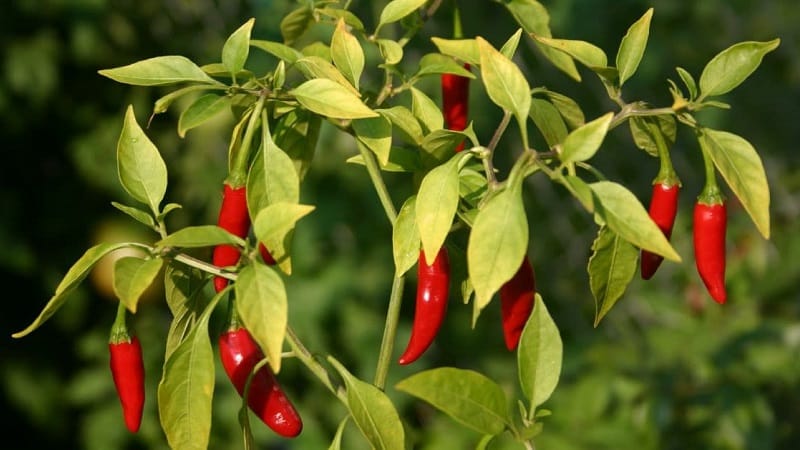
Common diseases late blight, fusarium, brown spot, black rot of fruits, black leg. Almost all of these diseases are fungal in nature and arise due to errors in watering and care.
For preventive purposes seeds are treated with potassium permanganate before planting.
Important! Peppers and tomatoes are relatives and are affected by the same diseases and pests. Therefore, peppers are not planted where nightshades previously grew.
With a black leg, rot appears the root part of the bush. Diseased plants are removed, and the remaining ones are watered with a solution of copper sulfate.
Sometimes the plantings are attacked by gray mold. In this case, the infected areas are removed, and the bushes are treated with garlic tincture. The same remedy helps protect peppers from late blight.
To prevent excess air humidity, the greenhouse is regularly ventilated. When planting seedlings, maintain sufficient distance between the bushes.
Reviews from gardeners
Judging by the reviews of gardeners, Growing a hot vegetable does not cause much trouble. The crop is cultivated both in greenhouses and greenhouses, and at home on the window. Here are a few reviews from those who grow hot seasoning on their own.
Oleg, Sochi: “I’ve been growing cayenne pepper for quite a long time, I already forgot when I bought this seasoning in the store, I always have my own. You just need a bigger pot, peppers love space. And so, in principle, he is not whimsical. Regularly pleases with a good harvest. I keep two bushes, that’s enough for me. I either grind ripe peppercorns or use them whole.”.
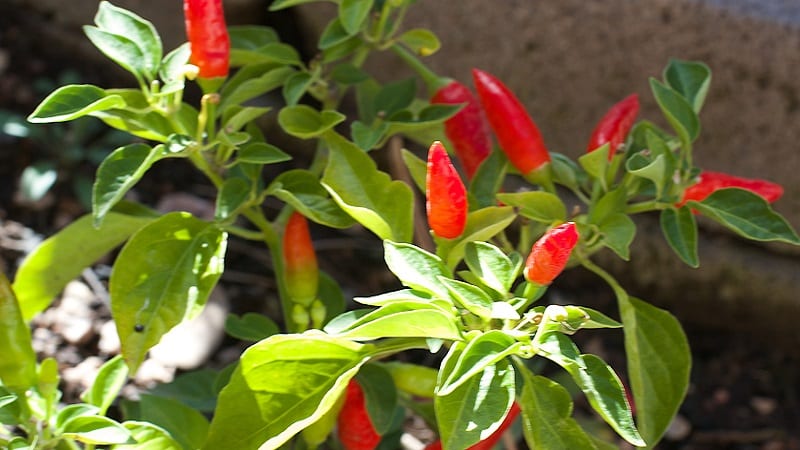
Galina, Moscow region: “This pepper is good for anyone who wants to lose weight.Just, of course, you need to be careful and not add it to all dishes in a row. It can be added to light salads, as well as to dishes with chicken and veal, then it will be beneficial.”.
Katya, Perm: “Great pepper! I’ve been growing this pepper for the second or third year now, everyone likes it, I add it when I stew meat, I make pastes with it, I even made spicy ketchup from my tomatoes and this pepper. It turned out great!”
Conclusion
Cayenne pepper is not only a healthy spicy vegetable, but also a very ornamental plant. The culture is undemanding to care and has a large number of useful properties. Moderate consumption of hot seasoning benefits the body and gives dishes a unique aroma and bright taste.